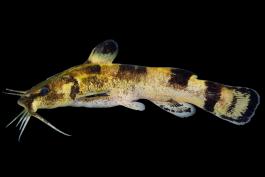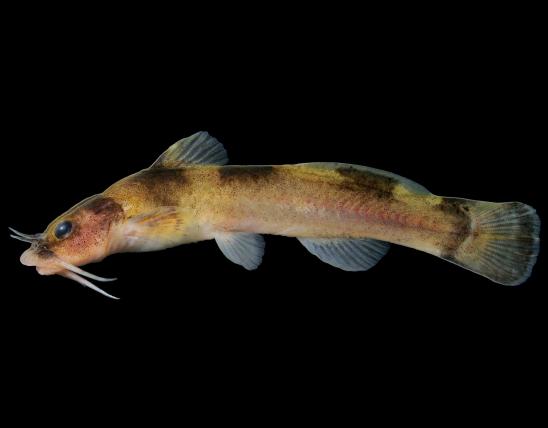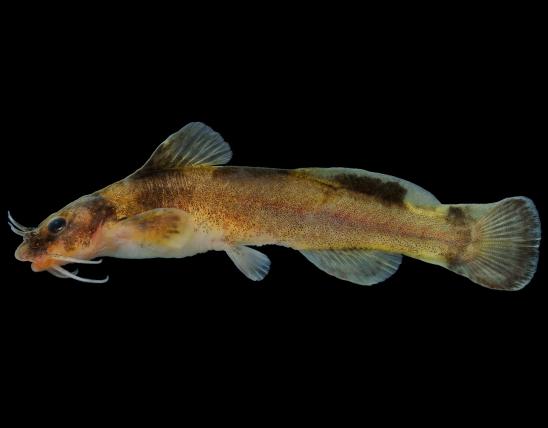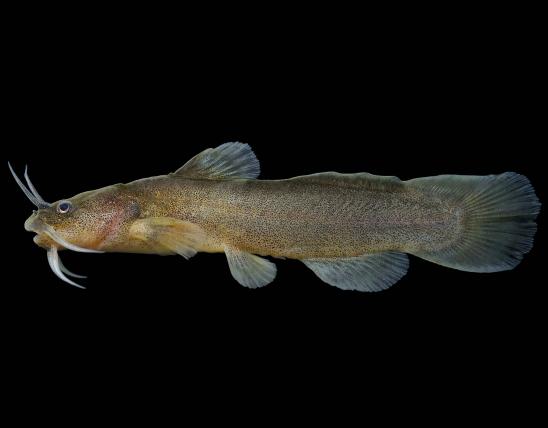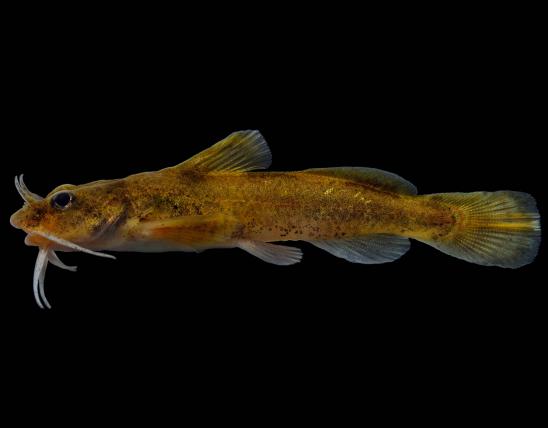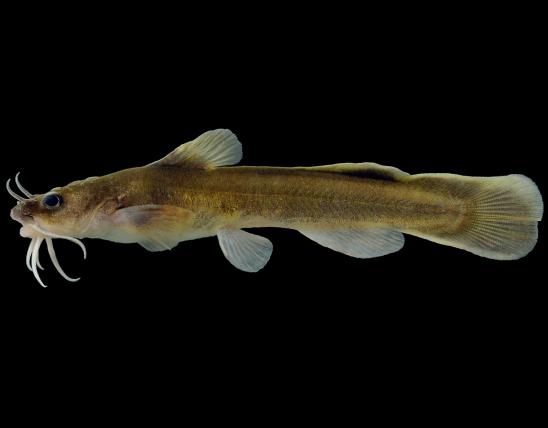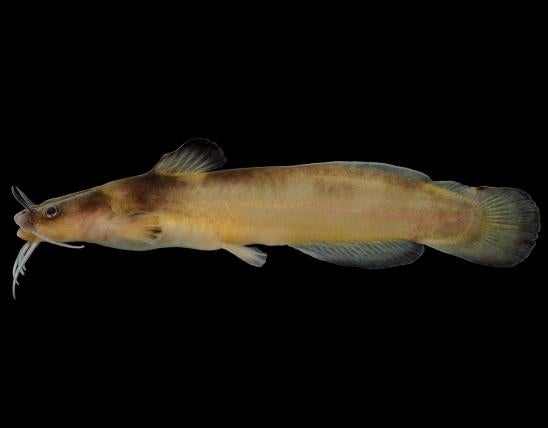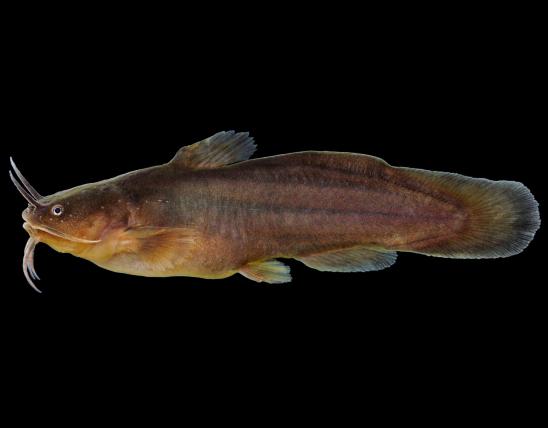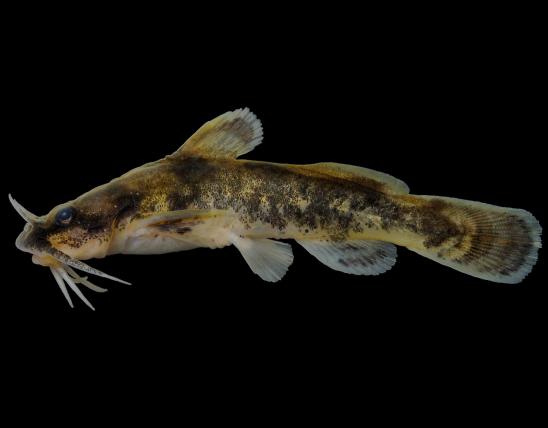
The checkered madtom is a small catfish prominently marked with four dark saddle marks and a bold dark bar at the base of the tail fin. It occurs in the southern Ozarks, in the backwaters and margins of quiet pools of clear, flowing streams.
Madtoms, as a group, are small, secretive catfishes that most people never see. The key identifier for madtoms has to do with the adipose fin (the small, fleshy fin that is present on the midline of the back just ahead of the tail fin). In madtoms, the adipose fin forms a low, keel-like ridge without a free, flaplike lobe along the trailing edge. The adipose may be connected to the tail fin, or it may have (at most) a slight notch in between. (In our other catfishes, the adipose fin forms a free, flaplike lobe, widely separate from the tail fin.)
The checkered madtom has the body and fins marked by prominent dark bars and blotches. The dark bar beneath the adipose fin reaches upward to the fin margin. A broad dark bar extends across the base of the tail fin. The dorsal fin has a dark blotch near the outer margin; this blotch extends across all the fin rays except the last. The pectoral spine has prominent, sawlike teeth along the rear margin. The upper jaw projects beyond the lower jaw. The tooth pad on the upper jaw lacks backward extensions. The head length (from the front tip of the head to the back of the gill cover) goes fewer than 3.5 times into the standard length (from the front tip of the head to the base of the tail fin). The distance from the tip of the tail fin to the notch between the tail fin and adipose fin goes less than 2 times into the distance from the notch forward to the front of the dorsal fin base.
The back is yellowish with dusky mottlings and 4 prominent black crossbars; the bar at the base of the tail fin extends vertically downward and encircles the body. The sides are yellowish with dusky mottlings. The belly is pale yellowish white. The fins are marked by prominent black bands and blotches.
Most madtoms possess a mild venom that is associated with the pectoral and dorsal spines. When introduced into a puncture wound produced by the spine, the venom causes a painful reaction. The spines are often erected and locked in place when the madtom is alarmed, increasing the chance of a puncture. The venom is not considered dangerous to people, and the chances of being “spined” are not great if the possibility is kept in mind when handling a madtom. If you’ve been jabbed by a madtom spine and think you’re having a severe reaction, seek medical attention.
Similar species: There are about 30 species of madtoms (in the genus Noturus), and all occur in the central and eastern United States and nearby parts of Canada. In Missouri, 10 species of madtoms have been recorded. It can be difficult to separate the different species of madtoms using the traditional methods of fish ID (counting fin rays, for instance, or comparing ratios of body-part measurements). Noting differences in pigmentation (such as dark bars or patches) can help, but such coloration often varies by particular locality and habitat (such as amount of vegetation, turbidity, or different substrates). Color can also vary by a fish’s health, mood, breeding condition, sex, and individual genetics, and dead fish may show little coloration at all. Molecular (DNA) date is being used more and more as a way to separate the species; of course, it is not very useful in the field. Geography can be a good clue for species IDs, since different species may be restricted to certain stream systems and never occur in others.
Habitat and Conservation
A characteristic madtom of Missouri’s southern Ozark streams. The checkered madtom inhabits clear Ozark rivers having high gradients and permanent strong flow. Except when spawning, it occurs in backwaters and along the margins of quiet pools, often where there are thick deposits of leaves, sticks, and other organic debris.
Like other madtoms, the checkered madtom is secretive and nocturnal, remaining beneath cover in the daytime and ranging actively over the bottom at night in search of food.
The distribution is similar to that of the Ozark and Black River madtoms. In streams where it coexists with those madtoms and the slender madtom, it is generally less abundant. Its preference for backwaters and quiet pools with accumulations organic debris is different from that of the Ozark and Black River madtoms, which are more commonly found in riffles and rocky pools.
The checkered madtom seems to be declining in the White River system. It may have been eliminated from part of its former range in this drainage by reservoir construction. It is still found, however, in Lake Norfork.
Food
Status
Life Cycle
Human Connections
Madtoms can be interesting aquarium fish. They do not reach the large size other catfish do, so they are unlikely to outgrow a normal-sized aquarium. Nongame fishes may be collected for aquarium purposes by the holder of a fishing permit, using techniques and in numbers specified for bait collecting in the Wildlife Code of Missouri.
These diminutive catfish can inflict a painful puncture wound with the spines on their pectoral and dorsal fins. Like all of Missouri’s catfish species, madtoms have venom glands at the base of these fins. The glands secrete venom that becomes incorporated in the slime and cells that make up the spine. Because madtoms are so small, it's difficult to avoid their tiny, sharp spines, especially if you are trying to impale them on a fishing hook. Many describe the pain that comes from being “horned” by a madtom as similar to a bee sting. Others claim it to be much worse. It’s best to handle madtoms carefully.
Non-point-source pollution is an important concept for people to understand. It’s easy to see how dumping a pollutant right into a stream can degrade water quality, but it’s a little harder to grasp how oil, detergent, salt, fertilizer, or pesticide applied to land that seems far from a stream is ultimately washed into our waterways. It’s also harder to see how construction or other soil disturbance on “dry land” can lead to siltation in nearby streams. Fortunately, people can learn these principles and take care to prevent our streams from being degraded.
Ecosystem Connections
We all know the story about the “big fish” eating the “little fish.” Madtoms are rather small, compared to other catfishes, and as such are more vulnerable to predation throughout their lives. The mildly venomous spines of the madtoms are one adaptation that helps them avoid being eaten.
Madtoms’ nocturnal lifestyle helps these small catfish avoid smallmouth bass, which hunt by sight during the day.
Eggs and fry of madtoms are eaten by crayfish, stonerollers, and darters.
Madtoms are part of the complex web of feeding relationships that occur in streams. Though small, madtoms are often abundant in streams, and their populations represent a significant link in the food chain.

